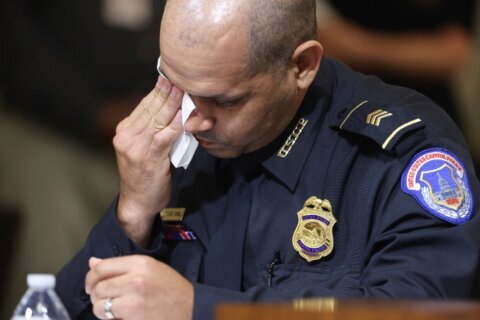No one who remembers seeing them will ever forget the attacks of Sept. 11, 2001. But 20 years later, they’re almost as far in the rearview mirror as the Carter presidency was when the attacks happened. An entire generation of children has been born, raised and graduated high school since then, and even some teachers today were children in 2001.
The attacks are a historical event now — a subject taught in schools. And an expert who has been studying how Sept. 11 and its aftermath are taught said that historical distance has created problems for teachers.
Jeremy Stoddard, a professor at the University of Wisconsin, has led surveys of teachers, looking to see how Sept. 11 is taught, and what teachers wish they could have to teach it more effectively.
He’s one of the curators of a website with resources and guides for teachers on Sept. 11, that include primary sources — news accounts and broadcasts from the day, as well as fictional and nonfictional works to provide context on the rise of the Taliban, Osama bin Laden and other related themes.
The main split in the way Sept. 11 is taught, Stoddard said, is whether to teach it as a memorial, or as an event that continues to have an effect on students’ lives. And a lot of factors go into that.
In places where teachers don’t have a lot of time or resources, they end up “teaching about these events only, sort of, on the anniversary, and a little bit out of context,” Stoddard said. “And that’s because their own curriculum doesn’t include it, or it includes it at the very end, after the test.”
On the anniversary, he added, “They’re going to show some of the news footage or a piece of a documentary, maybe talk about how they experienced that. They want to try to have students understand how they felt that day, and have them … try to get a sense of how most people in the U.S. would have witnessed that — which was through a television.”
In systems and classes with better resources, teachers can take a longer view. Sept. 11 is included in other units “looking at big trends over the past, 50 or 100 years,” Stoddard said. In some classrooms, Stoddard said, teachers compare and contrast Afghanistan and Vietnam, Sept. 11 and Pearl Harbor.
“9/11 fits in when you’re looking at the trajectory out of the Cold War, and out of globalization and things … then you sort of teach it within that context,” he added. “Or as part of the modern Middle East — for example, a lot of world history teachers will teach it, and then it fits in nicely.”
- Echoes from 9/11 grow louder as future threats emerge
- The three men who guided millions of Americans through the day’s horrors
- US to review 9/11 records with eye toward making more public
- Teaching Sept. 11 as history: ‘We could do a better job’
- How events such as Sept. 11 have affected our collective mental health
The changing balance of privacy vs. security and the equation of Islam with terrorism are two aftereffects of Sept. 11. You can’t understand the recent withdrawal of U.S. troops from Afghanistan — or why they were ever there — without knowing about Sept. 11.
“You don’t understand [then-President Donald Trump’s attempted] Muslim travel ban without understanding that context of 9/11,” Stoddard said.
He pointed out that on the morning of the attacks, before the first plane hit the World Trade Center in New York, the lead story on NBC’s Today show was about how an unmanned U.S. aircraft was shot down over Iraq. “Well, why is the U.S. in Iraq at that time? What’s going on?”
All these aspects, Stoddard said, are worthwhile ways to connect Sept. 11 to the world today’s kids are growing up in — if teachers have the time.
Misinformation, time constraints
When Stoddard and his fellow researchers asked teachers about their biggest challenges in teaching about Sept. 11, they thought the most common problem would center on the political ramifications of the event and its aftermath, particularly the lack of weapons of mass destruction in Iraq, the stated reason for the 2003 invasion.
But they found a surprising number of teachers said “students coming in today know very little about 9/11,” Stoddard said. “And so [teachers] are realizing they have to put some of that context.”
And it turns out that a lot of what the students think they know is wrong. Teachers “actually were seeing a lot of either misinformation, or even conspiracy theories coming into class,” Stoddard said.
Students were Googling Sept. 11 “and finding some of these conspiracy theory videos, and then coming into class and talking about 9/11 in that way — not in a way that was malicious by any means.”
“Kids coming in with either very little information or … all over the place, some incorrect information, is a real challenge,” Stoddard said. And because it isn’t generally a core part of teachers’ curriculum, “They’re not necessarily seeing the amount of time they want to spend on it to try to correct that.”
People who remember the invasion of Iraq, which followed in 2003, will surely remember the feverish arguments over the justification for the move, and the connection of Iraqi leader Saddam Hussein to the attacks — or lack of these justifications and connections.
Stoddard said that as the years have gone by, that’s been less of a point of contention in schools. Many textbooks “appeared with the original justification, of weapons of mass destruction and uranium, and then the next edition that section was taken out, and the invasion for Iraq was justified solely by Saddam Hussein and regime change.”
While some areas, especially those with high concentrations of military families, might still see some contention over “Some things that would have been viewed as controversial at the time now are becoming more normal in classrooms — but a lot of things still aren’t, necessarily.”
‘Will it be taught at all?’
Twenty years after Sept. 11, 2001, the events of that day, and the reaction to them, still cast a shadow on American life.
“I think we can do a better job in that sense,” Stoddard said. “And that’s true of history in general — we are not doing a great job of looking at current events and their historical roots. And so I think this is one way to do that.”
It’s natural to see the withdrawal from Afghanistan as the close of a chapter in history — the most direct response to the attacks — and Stoddard said it would be interesting to see how the entire era is portrayed in the future.
Major textbooks aren’t necessarily written by historians, Stoddard said. “They have an editorial team that’s making updates, and they have space limitations, then they’ve got rules around how many images can be in there, … and all these things. And those all shape how that history is going to be represented in the book. … What information is included or not included? You know, that’s shaped by a number of factors.”
He added, “Over the next 15 to 20 years, it’ll be interesting to see how that shifts, if at all, — or even how much it’s taught. And if it’s not taught on the anniversary anymore, then will it be taught at all? And I think that’s a question I certainly can’t answer.”








